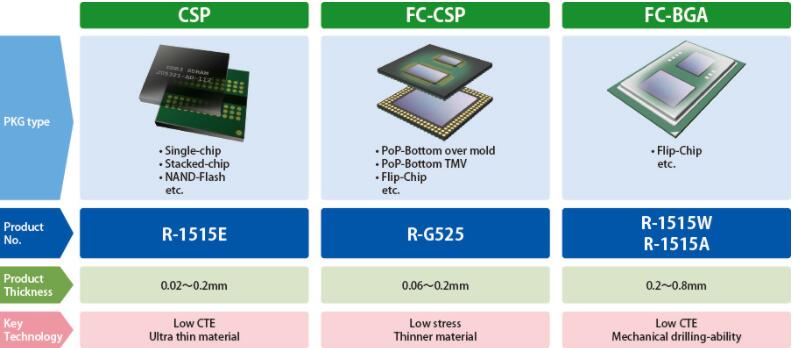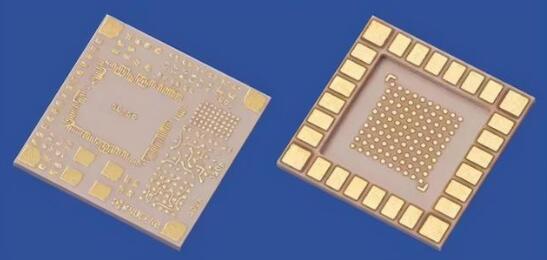The packaging substrate is the largest cost of IC packaging, accounting for more than 30%. IC packaging costs include packaging substrates, packaging materials, equipment depreciation and testing, among which the cost of IC substrate boards accounted for more than 30%. It is the largest cost of integrated circuit packaging and occupies an important position in integrated circuit packaging. For IC substrate boards, the substrate materials include copper foil, substrate, dry film (solid photoresist), wet film (liquid photoresist) and metal materials (copper balls, nickel beads, and gold salts), of which the substrate accounts for The ratio exceeds 30%, which is the largest cost end of IC substrate boards.
1. One of the main raw materials: copper foil
Similar to PCB, the copper foil required for IC substrate board is also electrolytic copper foil, and it needs to be ultra-thin uniform copper foil, the thickness can be as low as 1.5μm, generally, 2-18μm, while the thickness of copper foil used in traditional PCB is 18, Around 35μm. The price of ultra-thin copper foil is higher than that of ordinary electrolytic copper foil, and it is more difficult to process.
2. The second of the main raw material: substrate board
The substrate of the IC substrate board is similar to the copper-clad laminate of the PCB, which is mainly divided into three types: hard substrate, flexible film substrate and co-fired ceramic substrate. Among them, hard substrate and flexible substrate have more room for development, while the development of co-fired ceramic substrate Tends to slow down.
The main considerations for IC substrate substrates include dimensional stability, high-frequency characteristics, heat resistance and thermal conductivity and other requirements.

At present, there are mainly three materials for rigid packaging substrates, namely BT material, ABF material and MIS material;
Flexible packaging substrate materials mainly include PI (polyimide) and PE (polyester) resin
Ceramic packaging substrate materials are mainly ceramic materials such as alumina, aluminum nitride, and silicon carbide.
Rigid substrate materials: BT, ABF, MIS
1. BT resin material
The full name of BT resin is bismaleimide triazine resin, which was developed by Mitsubishi Gas Company of Japan. Although the patent period of BT resin has expired, Mitsubishi Gas Company is still in the leading position in the development and application of BT resin. BT resin has many advantages such as high Tg, high heat resistance, moisture resistance, low dielectric constant (DK) and low dissipation factor (Df), but due to the glass fiber layer, it is harder than the FC substrate made of ABF. The wiring is more troublesome, and the difficulty of laser drilling is higher, which cannot meet the requirements of fine lines, but it can stabilize the size and prevent thermal expansion and contraction from affecting the line yield. Therefore, BT materials are mostly used for networks with high-reliability requirements. Chip and programmable logic chip. At present, BT substrates are mostly used in products such as mobile phone MEMS chips, communication chips, and memory chips. With the rapid development of LED chips, the application of BT substrates in LED chip packaging is also developing rapidly.
2. ABF material
ABF material is a material led by Intel and used for the production of high-end carrier boards such as Flip Chip. Compared with BT base material, ABF material can be used as IC with the thinner circuit, suitable for high pin count and high transmission, and is mostly used for large high-end chips such as CPU, GPU and chipset. As a build-up material, ABF can be used as a circuit by directly attaching ABF to the copper foil substrate, and there is no need for a thermocompression bonding process. In the past, ABFFC had the problem of thickness. However, as the technology of copper foil substrates is becoming more and more advanced, ABFFC can solve the problem of thickness as long as the thin plate is used. In the early days, ABF substrate boards were mostly used for CPUs in computers and game consoles. With the rise of smartphones and changes in packaging technology, the ABF industry has fallen into a low ebb, but in recent years, network speeds have increased and technological breakthroughs have brought new high-performance computing applications to the table. The ABF demand is magnified again. From the perspective of industry trends, ABF substrates can keep up with the pace of advanced semiconductor manufacturing processes and meet the requirements of fine lines and fine line width/line spacing. The future market growth potential can be expected. With limited production capacity, industry leaders have begun to expand production. In May 2019, Xinxing announced that it expects to invest 20 billion yuan from 2019 to 2022 to expand high-end IC flip-chip substrate factories and vigorously develop ABF substrates. In terms of other Taiwanese manufacturers, Jingsus expects to shift the production of similar substrates to ABF, and Nandian is also continuing to increase production capacity.
3. MIS substrate
MIS substrate packaging technology is a new type of technology that is currently developing rapidly in the analog, power IC, and digital currency markets. MIS is different from traditional substrates in that it contains one or more layers of pre-encapsulated structures, and each layer is interconnected by electroplating copper to provide electrical connections during the packaging process. MIS can replace some traditional packages such as QFN packages or lead frame-based packages because MIS has finer wiring capabilities, better electrical and thermal properties, and a smaller profile.

Flexible substrate materials: PI, PE
PI and PE resins are widely used in flexible PCBs and IC substrate boards, especially in tape IC substrate boards. Flexible film substrates are mainly divided into three-layer adhesive substrates and two-layer adhesive-free substrates. The three-layer rubber sheet was originally mainly used for military electronic products such as launch vehicles, cruise missiles, and space satellites, and later expanded to various civilian electronic product chips; the thickness of the rubber-free sheet is smaller, suitable for high-density wiring, and is heat-resistant., Thinning and thinning have obvious advantages. Products are widely used in consumer electronics, automotive electronics and other fields, which are the main development directions for flexible packaging substrates in the future.
There are many upstream substrate material manufacturers, and the domestic technology is relatively weak.
There are many types of core material substrates for IC substrate boards, and most upstream manufacturers are foreign-funded enterprises. Take the most used BT materials and ABF materials as examples. The main global hard substrate manufacturers are Japanese companies MGC and Hitachi Korean companies Doosan and LG. ABF materials are mainly produced by Japan Ajinomoto, and the country has just started.